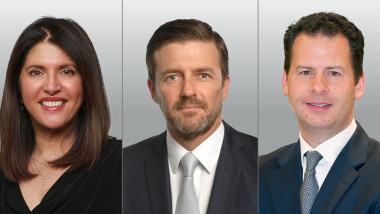Views from the Collective: Are Individual Investors Ready for Private Assets?
Investments in these so-called ‘alternatives’ – real estate, infrastructure, private equity, and private debt – have certainly not been immune to macroeconomic shocks. “The UK market lost about 20% in value over the last four months of 2022, which is a huge reduction,” said Rob Wilkinson, CEO of real estate specialist AEW.
For some, this was a stark reminder of the dangers of complacency about market volatility, following a decade of low inflation and low interest rates. Yet, as others pointed out, private assets did not suffer from the 2022 market shocks to the same extent as stocks and bonds – by their nature, unlisted assets don't have daily market dealing so they tend to be less volatile than public assets.
Indeed, the panel agreed that, for institutional investors looking for yield, stable and predictable cash flows, decorrelation from traditional asset classes – and reduced volatility compared to equity markets – the attractions of alternative investments remain unchanged.
Gwenola Chambon, CEO of Paris-based Vauban Infrastructure Partners, explained: “More than anything else, infrastructure provides a hedge against inflation, and infrastructure cash flows are going to go up because we are in an environment of higher inflation.”
Access all areas
Demand for private assets also remains strong, and there’s plenty of ‘dry powder’ – cash that's been committed by investors but has yet to be deployed by investment managers to be allocated to a specific investment.
According to the McKinsey Global Private Markets Review, total AUM for private markets reached $11.7 trillion in 2022 – an annual growth rate of nearly 20% since 2017. As of the second quarter of 2022, dry powder exceeded $3 trillion, reflecting an 8.4% year-on-year increase, and marking the eighth consecutive year of growth.
There’s a direction of travel with regulation too, which would seem to support the democratization of access to private assets among retail investors. For instance, the second version of the European Union's ELTIF (European Long Term Investment Fund) label is expected to be on the way by the end of the year.
However, ‘individual investors’ are a very broad customer segment, with different degrees of sophistication and risk profiles. The profile of a High Net Worth Individual, for example, is far closer to that of an institutional investor than a retail investor. That’s why, for the time being at least, private assets are still largely the preserve of institutions.
"While listed assets are held in a balanced way by institutional and retail investors, the same cannot be said for unlisted assets, which are more than 95% held by institutions," said Marc Romano, Head of Private Equity Funds at Paris-based sustainable investing specialist Mirova.
Then there’s the ‘illiquidity premium’: the trade-off of the potential for higher returns than more liquid assets versus the relative ease of valuation and ability to transact, as well as the potential difficulty in finding buyers and sellers. Put simply, many individual investors will not be familiar with the longer holding period associated with more illiquid investments.
Benoit de Kerleau, Managing Partner at private equity specialist Flexstone Partners, commented: "The level of risk taken by the investor should perhaps be modulated according to the type of client; institutional or private.”
Education is key
Fundamentally, individual investors need to understand what they are investing in. It’s therefore beholden on the distributor, be it a private bank or an investment platform, to provide the right information to the right client – and the more complex a product is, the more education is needed from the provider.
“In an ideal world you want to have all retail investors to be able to access all the private assets,” said Frédéric Nadal, CEO of private debt specialist MV Credit. “Nevertheless, it’s all about information, the choice of your distribution, or intermediaries… and the level of the complexity of the [investment]. It’s out of the question that we take the risk to sell something to someone who doesn’t understand the underlying product.”
Marc added: "The investment proposition is the same for institutional and retail investors, with similar levels of risk… but the packaging is different”.
However, for investors who do understand the risks and permutations of investing in private assets, and who partner with the right experts, there are plenty of ways of unlocking these types of investments. For instance, there are a growing number of sustainable solutions that invest in the real economy, like solar panels, tramways, or buildings.
“The sector that is currently keeping everyone super busy in Europe is the energy transition,” said Gwenola. “There is so much regulation incentivizing opportunities to adapt existing infrastructure to the new era of net zero carbon targets. All our existing infrastructure was built in a time when we had cheap energy costs… we have to address that by adapting existing infrastructure and conceiving new kinds of infrastructure investments.”
What’s more, many asset managers are now integrating ESG criteria into their investment approach as standard – driven by increasing demand from their clients, the market, and regulation. AEW, for example, is seeking to improve the energy efficiency of its buildings to reduce greenhouse gas emissions, but it’s also focusing on the broader social impacts too.
“The reality is that the industry and markets are pushing us towards ensuring our buildings are efficient from an energy standpoint,” explained Rob. “The more people want to invest in an asset that’s greener… and the more people want to be in greener buildings, all of this will drive our returns.”
As Frédéric concluded: "The revolution in ESG will have to come from individual investors, probably with some tax incentives from governments to help encourage them to invest in those strategies."
Vauban, Flexstone, Mirova, AEW and MV Credit are all affiliates of Natixis Investment Managers, and form part of our Expert Collective.
GLOSSARY
- Energy transition – the transformation of the global energy sector from fossil-based systems of energy production and consumption to renewable energy sources. Switching from non-renewable energy sources like oil, natural gas, and coal to renewable energy, such as wind or solar, is made possible by technological advancements and a societal push toward sustainability.
- ESG – (environmental, social, governance) is widely used in the investment industry to describe three types of non-financial factors that may affect the financial performance of a company or a security:
- Environmental may include factors related to renewable energy, lower carbon emissions, water management, pollution control and other ecological concerns.
- Social considerations may relate to labour practices, human rights, corporate social responsibility, data protection, selling practices or corporate supply chains.
- Governance issues can include the composition of boards of directors, corruption policies, auditing structure, executive pay or shareholder rights.
- ESG integration – refers to strategies that integrate ESG factors into fundamental analysis to pursue alpha and manage risk, or may use sustainable themes to identify investment opportunities. Certain ESG strategies may also seek to exclude specific types of investments.
- Illiquidity premium – the idea that, in return for potentially higher returns than more liquid assets, investments in private assets can offer a number of benefits, such as portfolio diversification, or more predictable cash flows, since they can be inflation-linked for the duration of a longer-term contract. Of course, the relative ease of valuation and ability to transact, as well as the potential difficulty in find buyers and sellers, are all factors that contribute to the asset’s illiquidity.




 Private assets: Is regulation a brake or an accelerator?
Private assets: Is regulation a brake or an accelerator?
 All back to bonds?
All back to bonds?
 Mirova B(ey)ond Green - Sustainable bond investments: What's new?
Mirova B(ey)ond Green - Sustainable bond investments: What's new?
 Mirova B(ey)ond Green - How can the emergence of ‘transition finance’ boost the market for labelled bonds?
Mirova B(ey)ond Green - How can the emergence of ‘transition finance’ boost the market for labelled bonds?